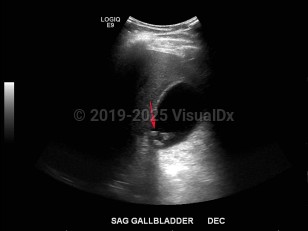Biliary calculus in All Ages
Alerts and Notices
Important News & Links
Synopsis
Hardened crystal deposits formed from bile pigments, cholesterol, and calcium salts found in the bile duct (choledocholithiasis) or gallbladder (cholecystolithiasis). Commonly called gallstones, they are characterized by severe right upper quadrant abdominal pain or epigastric pain due to transient obstruction of the biliary tract. Other symptoms include nausea, vomiting, hyperbilirubinemia, and elevated alkaline phosphatase and gamma-glutamyl transpeptidase.
Codes
ICD10CM:
K80.20 – Calculus of gallbladder without cholecystitis without obstruction
SNOMEDCT:
266474003 – Calculus in biliary tract
K80.20 – Calculus of gallbladder without cholecystitis without obstruction
SNOMEDCT:
266474003 – Calculus in biliary tract
References
Subscription Required
Last Updated:01/25/2016
 Patient Information for Biliary calculus in All Ages
Patient Information for Biliary calculus in All Ages
Premium Feature
VisualDx Patient Handouts
Available in the Elite package
- Improve treatment compliance
- Reduce after-hours questions
- Increase patient engagement and satisfaction
- Written in clear, easy-to-understand language. No confusing jargon.
- Available in English and Spanish
- Print out or email directly to your patient
Upgrade Today

Biliary calculus in All Ages

